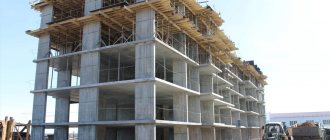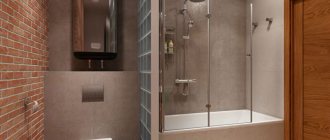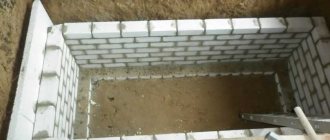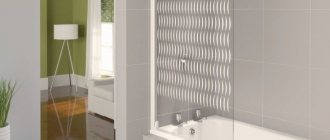Specific heat capacity of materials
Heat capacity is a physical quantity that describes the ability of a material to accumulate temperature from a heated environment. Quantitatively, specific heat capacity is equal to the amount of energy, measured in J, required to heat a body weighing 1 kg by 1 degree. Below is a table of the specific heat capacity of the most common materials in construction.
In order to calculate the heat capacity of a particular material, you must have the following data:
- type and volume of heated material (V);
- the specific heat capacity of this material (Sud);
- specific gravity (msp);
- initial and final temperatures of the material.
Thermal conductivity of building materials - Table 4
This is the final, but not the last, table in the series of thermal conductivity data. This table illustrates the thermal conductivity of building materials for urban construction - the figures are collected for a metal that is widely used in construction (steel), for glass, for cast iron (if you have a boiler or furnace), for plywood and for other materials.
Let's look at Table 4, which shows the thermal conductivity of building materials (some indicators for the same materials with different densities):
Can sand be used as insulation? Judging by the indicators for dry sand, yes. If you protect the sand from moisture, then it can be used in places where one of its characteristics is required - non-flammability. Sand is used as a heat insulator and heat dissipation element in so-called “sand boxes” when a chimney passes through floors made of combustible materials. Dry sand absorbs excess heat from the chimney (sometimes the temperature can be up to 800-1000 degrees C when soot burns in the chimney) and dissipates it, preventing the ceiling structures from igniting. Dry sand can be used both in the ceilings of the first floor and in the attic floors.
If sand gets wet, its thermal conductivity increases sharply and it loses its heat-insulating properties.
Thermal conductivity of non-ferrous metals and technical alloys
The table shows the thermal conductivity values of metals (non-ferrous), as well as the chemical composition of metals and technical alloys in the temperature range from 0 to 600°C.
Non-ferrous metals and alloys: nickel Ni, monel, nichrome; nickel alloys (according to GOST 492-58): cupronickel NM81, NM70, constantan NMMts 58.5-1.54, copel NM 56.5, monel NMZhMts and K-monel, alumel, chromel, manganin NMMts 85-12, invar; magnesium alloys (according to GOST 2856-68), electron, platinum-rhodium; soft solders (according to GOST 1499-70): pure tin, lead, POS-90, POS-40, POS-30, Rose alloy, Wood alloy.
The table shows that magnesium alloys and nickel have high thermal conductivity (at room temperature). Low thermal conductivity is characteristic of nichrome, invar and Wood's alloy.
For alloys, you can use the relation λ = LσT+ C, and L and C have the following values:
Heat capacity of building materials
The heat capacity of materials, the table for which is given above, depends on the density and thermal conductivity of the material.
And the thermal conductivity coefficient, in turn, depends on the size and closedness of the pores. A fine-porous material, which has a closed pore system, has greater thermal insulation and, accordingly, lower thermal conductivity than a large-porous one.
This is very easy to see using the most common materials in construction as an example. The figure below shows how the thermal conductivity coefficient and the thickness of the material influence the thermal insulation qualities of external fences.
The figure shows that building materials with lower density have a lower thermal conductivity coefficient. However, this is not always the case. For example, there are fibrous types of thermal insulation for which the opposite pattern applies: the lower the density of the material, the higher the thermal conductivity coefficient will be.
Therefore, you cannot rely solely on the indicator of the relative density of the material, but it is worth taking into account its other characteristics.
Types of bricks
In order to answer the question: “how to build a warm house from brick?”, you need to find out what type of brick is best to use. Since the modern market offers a huge selection of this building material. Let's look at the most common types.
Silicate
Sand-lime bricks are the most popular and widely used in construction in Russia. This type is made by mixing lime and sand. This material has become very widespread due to its wide range of applications in everyday life, and also due to the fact that its price is quite low.
However, if we turn to the physical quantities of this product, then not everything is so smooth.
Consider the double sand-lime brick M 150. The M 150 brand indicates high strength, so it even comes close to natural stone. Dimensions are 250x120x138 mm.
The thermal conductivity of this type is on average 0.7 W/(m oC). This is a fairly low figure compared to other materials. Therefore, warm walls made of this type of brick most likely will not work.
An important advantage of such bricks compared to ceramic ones is their soundproofing properties, which have a very beneficial effect on the construction of walls enclosing apartments or separating rooms.
Ceramic
The second place in popularity of building bricks is rightfully given to ceramic ones. To produce them, various mixtures of clays are fired.
This type is divided into two types:
- Building,
- Facing.
Construction bricks are used for the construction of foundations, walls of houses, stoves, etc., and facing bricks are used for finishing buildings and premises. This material is more suitable for DIY construction, as it is much lighter than silicate.
The thermal conductivity of a ceramic block is determined by the thermal conductivity coefficient and is numerically equal to:
- Full-bodied – 0.6 W/m* oC;
- Hollow brick - 0.5 W/m* oC;
- Slot – 0.38 W/m* oC.
The average heat capacity of a brick is about 0.92 kJ.
Warm ceramics
Warm brick is a relatively new building material. In principle, it is an improvement on the conventional ceramic block.
This type of product is much larger than usual; its dimensions can be 14 times larger than standard ones. But this does not greatly affect the overall weight of the structure.
Thermal insulation properties are almost 2 times better compared to ceramic bricks. The thermal conductivity coefficient is approximately 0.15 W/m* oC.
A block of warm ceramics has many small voids in the form of vertical channels. And as mentioned above, the more air in the material, the higher the thermal insulation properties of this building material. Heat loss can occur mainly on internal partitions or in masonry joints.
Comparative characteristics of the heat capacity of basic building materials
In order to compare the heat capacity of the most popular building materials, such as wood, brick and concrete, it is necessary to calculate the heat capacity for each of them.
First of all, you need to decide on the specific gravity of wood, brick and concrete. It is known that 1 m3 of wood weighs 500 kg, brick - 1700 kg, and concrete - 2300 kg. If we take a wall whose thickness is 35 cm, then through simple calculations we find that the specific gravity of 1 square meter of wood will be 175 kg, brick - 595 kg, and concrete - 805 kg. Next, we will select the temperature value at which thermal energy will accumulate in the walls. For example, this will happen on a hot summer day with an air temperature of 270C. For the selected conditions, we calculate the heat capacity of the selected materials:
- Wall made of wood: C=SudhmuddhΔT; Sder=2.3x175x27=10867.5 (kJ);
- Concrete wall: C=SudhmuddhΔT; Cbet = 0.84x805x27 = 18257.4 (kJ);
- Brick wall: C=SudhmuddhΔT; Skirp = 0.88x595x27 = 14137.2 (kJ).
From the calculations made, it is clear that with the same wall thickness, concrete has the highest heat capacity, and wood has the least. What does this mean? This suggests that on a hot summer day, the maximum amount of heat will accumulate in a house made of concrete, and the least amount of heat will accumulate in a house made of concrete.
This explains the fact that in a wooden house it is cool in hot weather and warm in cold weather. Brick and concrete easily accumulate a fairly large amount of heat from the environment, but just as easily part with it.
Types of materials and their characteristics
Brick, produced today in many types, is used in construction everywhere. Not a single object - a large industrial building, a residential apartment building or a small private house - is built without a brick foundation. The construction of cottages, popular and relatively inexpensive, is based exclusively on brickwork. Brick has long been the main building material.
This happened due to its universal properties:
- reliability and durability;
- strength;
- environmental friendliness;
- excellent sound and noise insulation characteristics.
The following types of bricks are distinguished.
Red. Made from fired clay and additives. It is distinguished by reliability, durability and frost resistance. Suitable for erecting walls and building foundations. Usually placed in one or two rows. Thermal conductivity depends on the presence of gaps in the product.
There are full-bodied ceramic briquettes, fire-resistant and slotted, with voids. The heat conductivity coefficient depends on the weight of the brick, the type and number of cracks in it. Warm ceramics are beautiful on the outside and have many fine gaps inside, making them very warm and therefore ideal for construction. If the ceramic product also has pores that reduce weight, the brick is called porous.
The disadvantages of such bricks include the fact that individual units are small and fragile. Therefore, warm ceramics are not suitable for all designs. In addition, this is an expensive material.
As for refractory ceramics, this is the so-called fireclay brick - a burnt block of clay with a high thermal conductivity, almost the same as that of ordinary solid material. At the same time, fire resistance is a valuable property that is always taken into account during construction.
Fireplaces are made from such “stove” brick; it has an aesthetic appearance, retains heat in the house due to its high thermal conductivity, is frost-resistant, and is not susceptible to acids and alkalis.
Specific heat capacity is the energy required to heat one kilogram of material by one degree. This indicator is needed to determine the resistance to heat of the walls of a building, especially at low temperatures.
Heat capacity and thermal conductivity of materials
Thermal conductivity is a physical quantity of materials that describes the ability of temperature to penetrate from one wall surface to another.
To create comfortable indoor conditions, it is necessary that the walls have a high heat capacity and a low thermal conductivity coefficient. In this case, the walls of the house will be able to accumulate thermal energy from the environment, but at the same time prevent the penetration of thermal radiation into the room.









